Last Updated on April 22, 2023 by Uncle Pat Ugwu
Research has shown that people learn differently. Finding out the best learning pattern for students may be very difficult. But once you discover what does the job, you will be happy to use it to increase the learning capabilities and retention of your students both in online and offline classes.
In this post, I shall look at the hybrid learning model and how it can be used to improve students’ understanding. Employing different approaches to teaching makes the students not to be bored while learning. That is why I am committed to helping teachers perform better in their chosen careers.
To begin this discussion on the hybrid learning model, let me remind you that we previously wrote a guide on gamification in education posts.
Now, let us begin.
Hybrid Learning Model
Hybrid learning integrates in-person and online education into a seamless learning experience. Roughly half of the class sessions are held on campus, with the other half conducted online.
The notion behind hybrid learning is to provide students some choice over the speed, location, path, and timing of their learning while combining the best of in-person and distant digital-learning methodologies.
Five Elements of Hybrid Learning
Do you have any ideas on what the primary pillars of hybrid learning could be in the future?
1. Structure or Layout
A new reform usually brings with it new obstacles. So, if you intend on a hybrid learning model, you must first examine the current course bundle.
Certain components of the course are always more difficult and may be taught better in a face-to-face setting, while others are better digested through infographics and online videos.
As a result, it would be ideal if all teachers of a certain topic could agree on a course based on the timetable. You also receive the extra responsibility of a good communication process with hybrid learning. Then, always ensure that your communication is on par and that everyone is informed of any changes.
2. Collaboration on Flexible Instruction
Some students require regular sessions for question clearing and more motivating direction, whilst others are self-sufficient. Giving students tips on how to use Google Maps in the Classroom will be good for students collaboration.
When it comes to education, though, even self-learners believe in regular discussions with their teachers and other students. In such instances, it is critical to organize learners who share common interests into a group where they may have a healthy discussion with instructors and other students about a variety of issues.
3. Self-Learning
To illustrate this notion, imagine that the teachers are planning a session on ‘Number theory.’ Teachers may teach the fundamental formulae online in a hybrid format, and then students can answer simple problems at home, and finally, in face-to-face meetings, they can clear their doubts and practice the difficult issues.
However, as attractive as the procedure appears in words, it may be difficult to carry out in practice. Therefore, the one talent that will assist your students to pass with flying colors is ‘self-learning’ which is one of the core components of the hybrid learning model.
4. Two-Ways Communication
For many years, schools have used student input to evaluate a teacher’s performance. However, it is past time for schools to solicit input on the subjects or courses taught and develop the curriculum accordingly.
Furthermore, schools must constantly examine students’ career interests. Yet, in a hybrid learning environment with a decreased batch size of up to 30%, teachers will have better clarity on each student’s interests, therefore their input will be important when determining which student to place in which session.
Schools may better develop curricula this way, and students will have more opportunities to thrive in their areas of interest.
5. Self-Direction
In a hybrid learning environment, self-evaluation will be critical. It would be interesting to see if schools asked students to research their performance insights for a year before setting monthly academic and non-academic objectives for themselves.
Students may do significantly better and emerge as leaders when accountability shifts from teachers to students. The students will be confident to perform because he knows that he is in charge.
Hybrid Learning vs Blended Learning
To describe the difference between blended and hybrid learning models, In essence, blended learning provides online content to in-person students to supplement their in-class experience whereas hybrid learning strives to maintain a balance between online and offline learning.
The Avid Open Access illustrated how to rotate different blended models. There is a post here on types of blended learning.
Why is Hybrid Learning Better?
Hybrid learning can increase class flexibility and personalization, learner accessibility, and tool utilization throughout courses. As a result, hybrid learning allows students to spend more time with their friends and family while also working on a schedule that works for them.
We wrote a comprehensive post on the benefits of hybrid learning, please check it out and learn more to learn more on the topic.
Final Thoughts
The hybrid learning model benefits students by increasing their accessibility, flexibility, knowledge of the topic, and collaboration on projects. I previously published an article about online teaching tips.
Schools can provide educational materials to physical and virtual venues and improve learning outcomes for students and teachers by integrating hybrid learning into their institutions.
Keep the conversation going under the comment section or using any of our social media handles.







